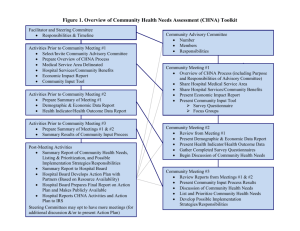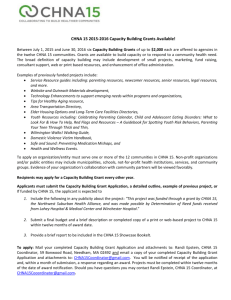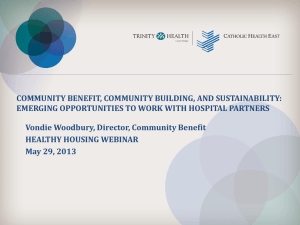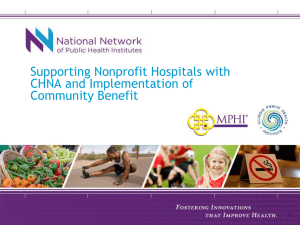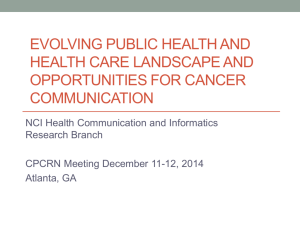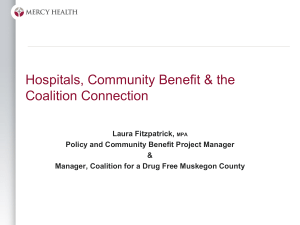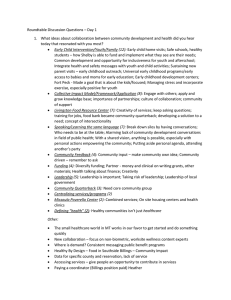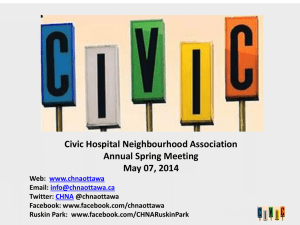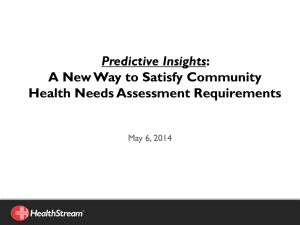ONE SIZE DOES NOT FIT ALL: UNDERSTANDING THE CHALLENGES AND
advertisement
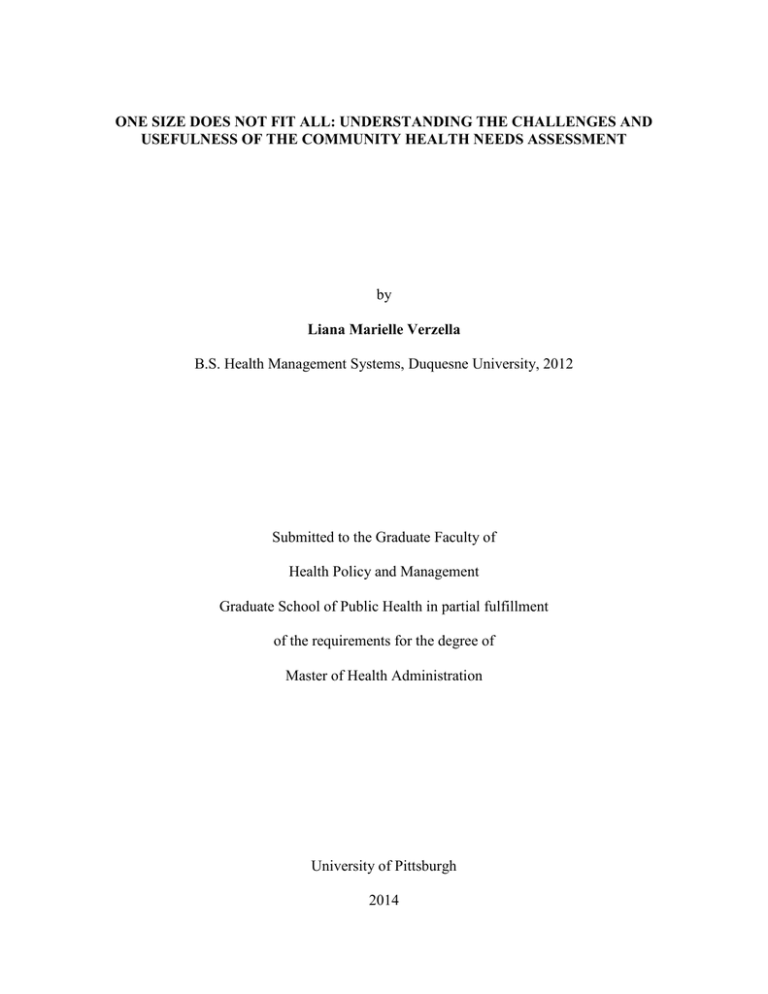
ONE SIZE DOES NOT FIT ALL: UNDERSTANDING THE CHALLENGES AND USEFULNESS OF THE COMMUNITY HEALTH NEEDS ASSESSMENT by Liana Marielle Verzella B.S. Health Management Systems, Duquesne University, 2012 Submitted to the Graduate Faculty of Health Policy and Management Graduate School of Public Health in partial fulfillment of the requirements for the degree of Master of Health Administration University of Pittsburgh 2014 UNIVERSITY OF PITTSBURGH GRADUATE SCHOOL OF PUBLIC HEALTH This essay is submitted by Liana Marielle Verzella on April 14, 2014 and approved by Essay Advisor: Nicholas Castle, MHA, PhD ______________________________________ Professor Department of Health Policy and Management Graduate School of Public Health University of Pittsburgh Essay Reader: Brenda Cassidy, DNP, MSN,CPNP-PC Assistant Professor School of Nursing University of Pittsburgh ______________________________________ Essay Reader: Pamela Schanwald, RN, MSHA CEO ______________________________________ The Children’s Home of Pittsburgh & Lemieux Family Center (If you have an extra reader, add their info; you can adjust the spacing on this page to fit it.) ii Copyright © by Liana Verzella 2014 iii Nicholas Castle, MHA, PhD ONE SIZE DOES NOT FIT ALL: UNDERSTANDING THE CHALLENGES AND USEFULNESS OF THE COMMUNITY HEALTH NEEDS ASSESSMENT Liana M. Verzella, MHA University of Pittsburgh, 2014 ABSTRACT The passing of the Patient Protection and Affordable Care Act and The Health Care Education Affordability Reconciliation Act of 2010 created new requirements and responsibilities for taxexempt hospitals, one of them being a community health needs assessment. In July of 2011, the IRS further clarified the requirements of the needs assessments and mandated that hospitals report their findings on the Schedule H of the Form 990. Although this process was created to help heath care systems best care for the needs of their communities’, these new expectations have put a strain on many healthcare organizations, especially those not positioned to meet the needs identified in their assessments. The community health needs assessment, or CHNA, seeks to understand the needs, health status, and behaviors of the community served by a hospital, yet it does not take into account the myriad and diversity of the tax-exempt healthcare organizations that make up today’s market. Is it realistic to assume that all healthcare systems can meet the same requirements, whether it is a 10-bed specialty hospital, or multi hospital, integrated healthcare system? In a time of healthcare reform, resource scarcity and economic instability, the CHNA adds another layer of complication for many healthcare organizations, yet it can also be a beneficial and resourceful asset. This piece takes a look into the usefulness and challenges of the CHNA, and the idea that it may not be a “one size fits all” process, as the IRS had originally iv anticipated. As healthcare is transitioning from acute episodic care to population based care, the CHNA will play a large role in the success of healthcare organizations achieving this goal. The CHNA will become a useful tool in the planning and implementation of population and community-based programs, and while improving the public health sector to help shape the future of healthcare. v TABLE OF CONTENTS PREFACE.................................................................................................................................VIII 1.0 INTRODUCTION................................................................................................................ 1 2.0 COMMUNITY HEALTH NEEDS ASSESSMENT: 101………………………………..3 2.1.1 Background……………………………………………………….............3 2.1.2 Reporting Requirements and Guidelines……………………………….5 2.1.3 ACA and Policy Implications…………………………………………...6 3.0 EXAMPLES OF CHNA PROCESS HEALTH NEEDS ASSESSMENT....................... 7 3.1 The Children's Home of Pittsburgh ............................................................................ 7 3.1.1 Background……………………………………………………………….7 3.1.2 Methods and Processes…………………………………………………...8 3.1.3 Outcomes………………………………………………………………...10 3.2 West Penn Allegheny Health System ........................................................................ 12 3.2.1 Background……………………………………………………………...12 3.2.2 Methods and Processes.…………………………………………………13 3.2.3 Outcomes………………………………………………………………...13 4.0 USEFULNESS OF A CHNA ............................................................................................. 15 5.0 CHALLENGES ................................................................................................................... 16 6.0 FINANCIAL IMPLICATIONS........................................................................................ 19 7.0 EFFECT ON PUBLIC HEALTH ..................................................................................... 20 Appendix A: Interview with Deborah Thompson.................................................................... 22 Appendix B: Interview with Mark LaRosa ............................................................................. 24 Appendix C: Interview with Kim Phillips ............................................................................... 26 Appendix D: The Children's Home: Initiative Selection Document ...................................... 27 Appendix E: The Children's Home: Pediatric First Aid Class Survey ................................. 28 Appendix F: The Children's Home: Baby Ready Pets Survey ............................................... 29 BIBLIOGRAPHY ....................................................................................................................... 30 vi LIST OF FIGURES Figure 1: The 6 steps of the CHNA process………………………………………………………5 Figure 2: The Timeline for the CHNA Process at The Children’s Home of Pittsburgh…………..9 Figure 3: Outcomes of the Baby Ready Pets Class at The Children’s Home of Pittsburgh……..11 Figure 4: Outcomes of the Pediatric First Safety Class at The Children’s Home of Pittsburgh…12 Figure 5: Top 10 Community Health Issues Identified by WPAHS…………………………….14 vii PREFACE The work in this essay is a product of my residency at The Children’s Home of Pittsburgh from January 2013 to January 2014. This essay is a collaboration of my work in completing and implementing a Community Health Needs Assessment for The Children’s Home of Pittsburgh, primary data from CHNA’s conducted in the market, and scholarly research. I would like to thank the management team at The Children’s Home of Pittsburgh, especially Pam Schanwald, for giving me the opportunity to complete the CHNA for the organization and for all of the guidance and mentorship during my residency. I would also like to extend many thanks to Dr. Nicholas Castle, Mark LaRosa, Kim Phillips, and Deb Thompson for your advice, tips, and assistance throughout this process. viii 1.0 INTRODUCTION In the healthcare sector, there has been much debate over the difference between the actions of nonprofit hospitals and for profit hospitals. Since 1969, nonprofit hospitals have been tax- exempt based off of their charitable nature and community benefit; however, there is a “growing concern that nonprofit hospitals are providing insufficient benefits to their communities in return for their tax-exempt status” (Principe et al. 2012). In response to the criticisms and controversy surrounding these organizations, federal mandates have forced hospitals to assess their charitable contributions. Since 2009, the Internal Revenue Service has required tax-exempt hospitals to complete a revised Schedule H and Form 990 which asks the organization to “Describe how the organization assesses the health care needs of the communities it serves” and report the value of community benefit that the hospital provides (Bilton, 21). This may have been the first “version” of a community needs health assessment, but with the enactment of the Affordable Care Act in March of 2010, a new requirement took effect that required all tax-exempt hospitals to complete a community health needs assessment every three years starting in 2012. Throughout the history of healthcare, non-profit hospitals have been a vital player in maintaining the health of our populations, in addition to providing community support. Hospitals that fall into Section 501(c)(3) of the Internal Revenue Code, defined as a charitable organization that provides healthcare to those who would otherwise be unable to afford it, have been given tax exemptions. The goal was to ideally, “Give nonprofit hospitals incentives to provide additional 1 benefits to their communities beyond providing health care service in exchange for reimbursement” (Rubin, Singh & Jacobson, 2013). In recent years, policymakers have questioned the adequacy and amount of actual benefit that these now almost 3,000 hospitals provide to the community, which has led to more stringent and thorough assessments of their tax-exempt status (http://www.aha.org). While hospitals have historically been seen as charitable organizations providing services to the poor, the evolution of the healthcare sector and influence of corporate business and financial incentives has shifted the focus of many organizations. The new community health needs assessment, or CHNA, is a “written document that describes the community served by the hospital and identifies the health needs of the community” (Rubin, Singh & Jacobson, 2013). Generally, the CHNA is a process used to identify the needs of a community and prioritize them, based on collecting and analyzing data, using internal and external resources, and gathering input from the community (Bilton, 23). One component of the CHNA requires hospitals to develop an implementation strategy to address the identified needs found in the assessment, along with actionable and measurable outcomes. This process “seeks to understand and document health status, behaviors, and needs in the community” using data collected by the hospital in addition to population indicators (Bilton, 22). According to an article in the American Journal of Public Health, the CHNA has “the potential to affect both the level and composition of community benefits as well as their concentration at hospitals in areas or markets with the most need for free or subsidized care” (Principe et al. 2012). These CHNA’s are not only intended to improve the health of the organization’s community, but also to help with the transition to population based healthcare across the country. Although the federal government has revised and imposed these new requirements for nonprofit organizations, there are still many questions left unanswered. The Association for 2 Community Health Improvement created universal guidelines to complete the CHNA process, but there are still many hurdles that hospitals must overcome to satisfy the requirements. Some say that many factors were overlooked when formulating the new demands, such as financial burdens, the usefulness of the outcomes, diversity among healthcare organizations, the overall affect on public health. 2.0 COMMUNITY HEALTH NEEDS ASSESSMENT 101 2.1.1 Background Section 501(c)(3) of the Internal Revenue Code requires that every tax-exempt hospital must conduct a CHNA at least one time every three years, and must “adopt an implementation strategy to meet the community health needs identified through the CHNA” (Federal Register, 2013). The IRS demands that each hospital define their community, although that definition is flexible and vague. The IRS expects a hospital to use its geographic location to determine the community it serves, but in some cases, “the definition might also take into account target populations served or specialized functions” (Federal Register, 2013). When completing a CHNA, hospitals also have to follow the proposed regulations that state which persons must be involved in the process. Organizations must get input from persons that represent the broad interests of the community and have knowledge of public health. The regulations require that input must come from “at least one governmental health department, members of the minority populations in the community or who represent the community and any written comments received on the hospital’s most recently conducted CHNA” (Federal Register, 2013). Along with this input, an organization must also collect demographic and statistical data on their community. The CHNA process is accomplished by collecting both qualitative and quantitative data in collaboration with input from community stakeholders and organization leaders and managers. 3 Although the CHNA is unique to each organization, the Association for Community Health Improvement, a group of the American Hospital Association, created a guide to help hospitals through their CHNA process. The ACHI (INSERT CITATION) established a six-step framework outlining the needs assessment process according to best practices, as follows: Step One: Establishing the Assessment Infrastructure The first step in any assessment is to identify all available resources, including staff, finances, and infrastructure. In this step, hospitals can look at the possibility of partnering with external organizations to provide extra resources and support. Step Two: Defining the Purpose and Scope Each hospital or healthcare system must define the geographic area and population of their community. This includes looking at primary, secondary and tertiary service areas, and examining the range of topics that will be assessed. Step Three: Collective and Analyzing Date Data collection sets the foundation for any assessment, especially the CHNA. Using a mix of existing data, internal operational data, demographics, healthcare indicators, and collected statistics, this step is crucial for organizations to create a baseline for their assessment. Step Four: Selecting Priorities It is the responsibility of the key stakeholders and those identified to prioritize the needs that have been identified at this point. Needs should be based on the data collected, and prioritized according to the organization’s resources and ability to meet those needs. Step Five: Documenting and Communicating Results A CHNA must be documented in a summary or report explaining the process and methods used to complete the assessment, including data collection, identification of needs, strategic plan, and outcome measurement. The report or summary must be made available to the public through the organization’s website and marketing efforts. Step Six: Planning for Action and Monitoring Progress Part of the ACA requirement is that hospitals that complete a CHNA must create and adopt an implementation plan. Many hospitals use this as an opportunity to re align their strategic plan and incorporate the results of the CHNA into their strategic goals. Hospitals must demonstrate their implementation strategy and how they intend to not only meet the identified needs, but how they will track and evaluate outcomes. 4 Step 1 Establish Assessment Framework and Resources Step 2 Define Purpose and Scope Step 3 Collect and Analyze Data Step 4 Prioritize Needs Step 5 Disseminate Results Step 6 Monitor and Evaluate Actions Figure 1: The 6 Steps of the CHNA Process (Source: Adapted from Association for Health Improvement) 2.1.2 Reporting Requirements and Guidelines In addition to organizing and completing the CHNA, hospital organizations must also document their process and create a report made available to the public. That report must describe the data used in the assessment, methods of collecting and analyzing the data, and identify any collaborations used during the process. The report must include: A definition of the community served by the hospital and a how the community was determined A description of the process and methods used to conduct the CHNA A description of how the hospital used the input received A prioritized description of the health needs identified A description of the potential measures and resources identified to address the needs (Federal Register, 2013) Supplemental to the CHNA report, a hospital organization must include their implementation strategy in their Form 990 to report to the IRS. The IRS amended this 5 requirement to allow hospitals to send a narrative summary description of its process and implementation strategy, and required that it be updated only every three years. The implementation strategy must state how the hospital plans to address the needs of the community that were identified in the assessment, or reasons why the hospital does not intend to address the needs. (Federal Register, 2013). Every hospital must make their CHNA report available to the public through their web site, including their implementation strategy. The hospital must also make public their updates on of the actions they have taken to address the needs identified in their report. Lastly, the organization must send the IRS a copy of its audited financial statements for the taxable year and disclose the amount of excise tax that was imposed if they failed to meet the requirements under section 501(r)(3) (Federal Register, 2013). 2.1.3 ACA and Policy Implications The Affordable Care Act places a large amount of responsibility on the tax-exempt hospitals to not only complete a CHNA, but also to follow a strict set of guidelines that were created by the federal government. Along with conducting a CHNA every three years, and creating an implementation strategy, every assessment must have representation from a broad interest in the community and must be made available to the public. While the CHNA was created with the purpose to help the organization efficiently and effectively provide healthcare to its community, there are also punitive damages if the requirements are not met. Any hospital that fails to meet the ACA’s requirements regarding the CHNA will face a $50,000 excise tax and may face the loss of their tax-exemption status (Federal Register, 2013). The policy implications of the CHNA provision of the ACA are an important factor in the amount of hospital expenditures on community benefits. With the continuation of ACA implementation, the 6 individual health insurance mandate, and the push toward community health, “the need for hospital based charity care should decline substantially (Young et al., 2013). The new policies are intended to place more accountability and transparency regarding a hospital’s community benefit activities and outcomes, while providing incentives and support for these nonprofit hospitals. 3.0 EXAMPLES OF COMMUNITY HEALTH NEEDS ASSESSEMENTS The ACA regulations require that a hospital must assess the health needs of its community through a CHNA by identifying needs, prioritizing those needs, and identifying potential measures and resources available to meet those needs. After clarification, it was determined that a CHNA only needs to recognize the most significant heath needs, and that “a hospital facility may determine whether a health need is significant based on all of the facts and circumstances present in the community it serves” (Federal Register, 2013). As each hospital and hospital system is unique and diverse, each CHNA process will be unique and altered to accommodate the organization’s resources and capacity. 3.1 THE CHILDREN’S HOME OF PITTSBURGH 3.1.1. Background The Children’s Home of Pittsburgh is a medium sized non-profit Pediatric Specialty Hospital located in Southwestern Pennsylvania. Established in 1893, the purpose of The Children’s Home is to promote the health and well-being of infants and children through their three programs, adoption, Child’s Way® daycare and their Pediatric Specialty Hospital. Their mission is to serve the medically fragile population from birth to age 18 in the greater Allegheny 7 County, and they achieve this by providing acute care for infants and children transitioning from the hospital to the home (http://www.childrenshomepgh.org/lemieux-family-center). 3.1.2. Methods and Processes Like every other 501c3 hospital, The Children’s Home had to complete a CHNA to qualify for their tax-exempt status. A CHNA was started in January of 2013 for the first time through a collaboration of management team members, community stakeholders, and consultants. The Children’s Home based their CHNA on the following factors: Improve access to healthcare Enhance the health of the community Advance medical or health care knowledge Relieve or reduce the burden of government or other community effort The Children’s Home chose to use the consulting group, Parente Bearde, to help them complete the CHNA process for fiscal year 2012. Because this was the first time that the organization was completing a CHNA, the organization used a variety of methods and resources, both internally and externally. The strategic CHNA plan was as follows: 1. Establish a Community Needs Committee– consultants, staff/board leaders, clinicians, 2. Review the CHNA strategic plan with the committee and revise the scope of work, project plan, timeline and responsibilities 3. Define “community” for purposes of the CHNA 4. Obtain community input on what the needs are of the community 5. Brainstorm and prioritize the community needs that fit with our mission 6. Establish initiatives and programs that will meet the needs of the community 7. Approve initiatives and develop implementation strategy to address needs 8. Adopt implementation strategy of initiative 9. Implement programs by June 30, 2013 and track the progress 10. Make information readily available to organization and community. 11. Establish communication protocol to ensure transparency 12. Determine how best to present needs and implementation strategy through Form 990 reporting. 8 In order to truly get a sense of the community’s needs, The Children’s Home created a Community Needs Committee that was comprised of stakeholders from diverse backgrounds, such as internal staff, Pittsburgh Public schools, The University of Pittsburgh School of Nursing, and Children’s Hospital of Pittsburgh of UPMC. The committee was tasked with developing policies for improving the health of communities served and ensuring that a dialogue was initiated and maintained with appropriate community stakeholders. The overarching goals of the CHNA were to: Understand our communities’ health care needs. Develop roadmap to direct resources where services are most needed and impact is most beneficial. Collaborate with community partners where together we can make a positive impact. Improve the health of our communities – achieve measurable results. CHNA Timeline February 8 Mid February End of February March April 1 April 25 May June 30 Review and Selection on Initiatives Complete Research on Initiatives Implementation Plan Outline Send Information to Committee for feedback Prepare Documentation for Submission CHNA Report and Form 990 Finalized and Presented to BOD Submit 990 Form and Report to IRS Initiatives Must be Fully Implemented Figure 2: Timeline of the CHNA Process for The Children’s Home of Pittsburgh (Source: The Children’s Home of Pittsburgh’s CHNA Documentation) The committee was tasked with prioritizing the healthcare needs of the community defined by The Children’s Home. Three questions were used to prioritize the needs: 1.How important is the problem to our community? 9 2.What is the likelihood of being able to make a measurable impact on the problem? 3.Does the hospital have the ability to address this problem? The committee used a survey created internally to rank the prioritized needs and vote on which issues to focus on and create a strategic plan for. 3.1.3. Outcomes After reviewing the strategic plan of the organization, the committee brainstormed on which community needs were a priority and how The Children’s Home could best meet those needs through a roundtable discussion. Using a list of predetermined needs based on demographic and geographic statistics, committee members brainstormed which needs were reasonable for The Children’s Home to take on. The committee discussed the importance of each topic and what resources that were available to meet each need, and how well each fit with the mission of the organization. Among the topics were childhood obesity, teen pregnancy, homelessness, injury prevention, and pediatric safety, to name a few. It was decided through the use of a brief survey that the safety and education of patients, their families, and the neighboring communities was a top priority. Based on the guidance and recommendations from the committee members, it was decided on unanimously to implement two new pediatric safety educational programs. Stemming from numerous requests and questions by patient families, the committee suggested collaborating with a local animal shelter by holding a pet safety course for families bringing new infants home. Using an already established program, Baby Ready Pets, the organization was able to easily create an implementation strategy for the program. The course, taught by two paramedics, was altered for The Children’s Home, and included pet safety information for medically fragile children, in addition to the original material taught in the course. Using the expertise and opinions of the committee, it was agreed upon that a much 10 needed program was a pediatric first aid class for parents and family member who care for infants and children. The first aid class was taught by a registered nurse on the committee with ties to the community, and provided basic education to ensure the safety of a child. Staying true to the mission of the children’s home, it was decided that the organization would offer a pediatric first aid class to the community at no cost, using resources that were already on hand and support from internal staff. The educational programs were offered to the community throughout the year and were evaluated by management to see the effectiveness of the classes. By the end of the year, the Baby Ready Pets class served over 12 couples and there were over 30 participants in the pediatric safety class, whose satisfaction results are below. Figure 3: Outcome of the Baby Ready Pets Class at The Children’s Home of Pittsburgh 11 Figure 4: Outcome of the Pediatric First Safety Class at The Children’s Home of Pittsburgh WEST PENN ALLEGHENY HEALTH SYSTEM 3.2.1. Background The purpose of the West Penn Allegheny Health System, WPAHS, is to improve the health of the people in Western Pennsylvania, and their mission is to “practice medicine, educate and conduct research as an integrated team of physicians, nurses and support professionals who are committed to improving the health of [their] patients” (www.wpahs.org). To accomplish this, the organization completed a community health needs assessment to understand the needs of the patients and communities they serve. Their CHNA process included the use of steering committees, development and implementation strategies, and qualitative and quantitative data collection. 12 3.2.2. Methods and Processes The WPAHS utilized a local planning and research firm, Strategy Solutions, Inc., to help them complete their CHNA for 2012-2013. Using a steering committee that was made up of community leaders, public health experts, board members, and internal leaders, the organization came up with a process that would examine the needs of their community. They defined their community by geographic location, specifically, at the counties that make up the primary service area for the WPAHS. Their process examined: Demographics Access to Quality Healthcare Chronic Disease Health Environment Healthy Mothers, Babies and Children Infectious Diseases Mental Health and Substance Abuse Physical Activity and Nutrition Tobacco Use Injury Primary data was collected through community focus groups and in-depth stakeholder interviews. WPAHS collected quantitative data from demographic and socioeconomic data through state and federal databases and statistic data sets. 3.2.3. Outcomes Data collected from the focus group participants through the use of an electronic polling system indicated top ten community health concerns. These health issues were also confirmed and explored by the stakeholders identified after being interviewed. The quantitative research results provided information on WPAHS’s service area in comparison to state and national data in the areas of: access, chronic disease, environment, infectious disease, mental health, nutrition, tobacco use, public health, and other health indicators. 13 Figure 5: Top 10 Community Health Issues Identified by WPAHS (Source: Reprinted with Permission from WPAHS CHNA Executive Summary) Through a collaboration of the steering committee, the hospital system, and the Suburban Health Foundation board, the data was analyzed and prioritized based on: 1. 2. 3. 4. The accountable entity The magnitude of the problem The impact on other health outcomes The capacity to implement solutions Based on the greatest needs related to the hospitals mission, capabilities and resources, the WPAHS decided upon implementing strategies to address the needs of the following conditions: Heart disease Pneumonia Multiple chronic conditions/medications among Medicare patients Diabetes and associated co-morbidities Breast, lung and colon cancer 14 The needs identified were met through the use of community education, outreach and health screenings, physician and EMS outreach and training, and programs to help patients with the continuum of care (www.wpahs.org). 4.0 USEFULNESS OF A CHNA Over the past few years, there has been a plethora of research and literature that explain the usefulness of needs assessments. An article in Nursing Standard journal states that a needs assessment is “a systematic method for reviewing the health issues facing a population, leading to the agreed priorities and resource allocation that will improve health and reduce inequalities’”(Holt & Jack, 2008). The article continues to explain that by completing a health needs assessment, hospitals will benefit from stronger community involvement, improved team and partnership working, professional development, and an overall better use of resources (Holt & Jack, 2008). According to a Trustee Executive Briefing from Health Forum by Michael Bilton, there are many benefits associated with the CHNA, including: Planning and targeting community health services Raising awareness of key health issues Benchmarking and monitoring health status improvements Regional health improvement collaboration (Bilton, 24). It is evident that the outcomes of the CHNA can be used in a variety of ways, and can help an organization align it’s strategic goals with the future of healthcare. Vice President of Planning and Business Development for The West Penn Hospital in Southwestern Pennsylvania, Mark LaRosa, stated that the CHNA process “provides an overall understanding of the diverse trends in the community and market, and helps define the scope of those trends” (LaRosa). He continued to explain that the CHNA is a useful tool for population health and the growing trends 15 toward innovative delivery systems, such as Accountable Care Organizations. The assessment not only helps the organization implement positive and useful programs, but it also creates health awareness to the community at a low cost. According to the Association for Community Health Improvement, a Community Health Needs Assessment helps an organization to: Review the community’s health status and unmet needs; Collect information to target community benefit and outreach programs; Meet the requirements mandated by the Patient Protection and Affordable Care Act for not-for-profit hospitals; and Create or strengthen partnerships among community organizations with shared accountability for the population’s health. (http://www.assesstoolkit.org/) The CHNA may be a strenuous process; however, the overall benefit and charitable intentions outweigh the challenges that hospitals must overcome, and helps to stress the importance of community involvement in a hospital’s decision-making process. 5.0 CHALLENGES The ACA’s requirements of the CHNA have gone through a series of revisions due to the lack of consistency and confusion surrounding the vagueness of the demands. Hospitals must figure out their role in the community and how they complete their CHNA all within compliance with the regulations. Regardless of the type, size, or availability of resources, every 501(c)(3) hospital must complete a CHNA, and herein lies the main problem. A 400 bed multi hospital integrated health system must follow the same requirements as a 20 bed specialty hospital, knowing that they have different spans of resources and capabilities to meet the communities’ needs. This challenge, along with the complexity of working with population and outcome based data, hinder healthcare organizations from successfully completing their CHNA. 16 Deborah Thompson, CEO of Get Strategy Solutions, commented on the CHNA process after her extensive experience helping healthcare organizations complete their process. A challenge, she noted, is that the outcome of the CHNA can vary and depends on who the organization took their lead from and who they looked to for guidance, whether that be consultants, strategic advisors, accountants, or their financial management. Many organizations look to their financial departments to drive their CHNA decisions, which may end up being financially biased and may steer the organization away from best practices. Mark LaRosa states that although he has seen the benefits of the CHNA, there are a myriad of challenges that he faces when completing the process. He commented that the CHNA is a very difficult process, which includes “tying the community’s needs into the organization’s strategic business initiatives. Collecting data and using key stakeholders in the community tells you about your needs, but it doesn’t tell you how to prioritize the critical issues, or how they are suppose to fit into your business plan” (LaRosa). He continues to explain that the assessment may reveal needs that are not within your organization’s scope, so you must choose the issues that you know you will have the resources to cover. In essence, the needs identified in the CHNA do not always fit within the core strengths of the organization, making it challenging successfully carry out. Another challenge is determining the scope of the service area to complete the CHNA on. Two organizations in the same geographic are tend to have different “communities,” resulting in different outcomes. In essence, the organization defines their community, which creates a challenge when it comes to continuity. Although many hospitals are having issues completing the assessment, the CHNA can be even more challenging and time consuming for smaller, niche hospitals, such as The Children’s Home of Pittsburgh. The Children’s Home of Pittsburgh, a 16-bed specialty Pediatric hospital, 17 completed its first CHNA in 2013. The Chief Financial Officer, Kimberly Phillips, commented that “this was a very hectic and overwhelming process for us…It is hard for small institutions, like ourselves, to complete the assessment without the input and resources needed” (Phillips). Challenges arise not only with resource allocation and financial obligations in these types of organizations, but also with manpower and staffing to support the CHNA process. A common challenge found across the industry is the underlying purpose of the CHNA. Many of the needs that arise from the assessment are socioeconomic problems in which hospitals do not have the resources to deal with. Mr. LaRosa commented that many of the needs they find have to deal with access to healthcare, such as transportation issues. The hospital is then faced with the burden of knowing this is a need in the community, but possibly not having the resources to fix it. The question then arises as to who is responsible for ensuring this need for access to care, and who will pay for it? Does it fall on the hospital itself, or does the local, state and federal government have a responsibility to meet those needs? It seems that the CHNA process was created as though all hospital organizations are the same, with comparable populations, service lines, resources, and operational capacity. This “blanket statement” has led to the continued frustration and confusion among hospitals that are attempting to successfully complete a CHNA. From the lack of clarification on the definition of “community,” to the vagueness of the requirements and outcome measures, the CHNA has many systematic flaws in trying to incorporate an outcome based, population approach to healthcare (Rubin, Singh & Jacobson, 2013). 18 6.0 FINANCIAL IMPLICATIONS As noted in much literature, the CHNA has an effect on the financial operations of many healthcare organizations. The New England Journal of Medicine published an article that concluded that “tax exempt hospitals spent 7.5% of their operating expenses on community benefits during fiscal year 2009” (Young et al., 2013). While it may have been originally overlooked, healthcare organizations may be affected financially by the CHNA, depending on the capacity of the organization. These hospital systems have much at stake when completing a CHNA, as they may face losing their tax-exempt status if they fail to meet the set requirements (Mondaq Business Briefing, 2013). Deborah Thomas explained that the CHNA process is going to drive hospital planning and evaluation of clinical programs and their reimbursement systems. She stated that “bundled payments are going to be a large influence on healthcare systems, and the CHNA will drive that and have an impact on what services should be offered and bundled. It will help organizations strategize and streamline services so that new interventions are based on the need of the community” (Thomas). Coming from a strategic planning point of view, Mark LaRosa described that the CHNA allows a hospital to offer beneficial programs to the community that are impactful and low cost. He added that the process and follow through of the programs “take resources away from other operations. It adds another layer of responsibility to the organization” (LaRosa). As Chief Financial Oficer for a Pediatric specialty hospital, Kim Phillips rationalized that while the CHNA process and effort to improve transparency is valuable, this was implemented at a time when reimbursements are being cut, and healthcare organizations are being held at a 19 higher standard of giving free services, mentioning that “This creates more strain on organizations, and forces resource allocation and the potential of cutting programs” (Phillips). Most of the initiatives and programs that result from a CHNA are not revenue generating, and since many organizations already have strategies set in place to address the communities needs prior to the CHNA, the process has a negative financial impact (LaRosa). The information collected from these primary sources is consistent with the literature, concluding that there are financial implications for a hospital organization completing a CHNA. 7.0 EFFECT ON PUBLIC HEALTH The transition from individual to population healthcare is not only present in today’s healthcare sector, but will be for years to come. The CHNA both directly and indirectly affects the healthcare industry, particularly in public health. With the influence of community input from the CHNA, hospital organizations can improve awareness and health status in their communities and help to align with the mission of public health. An article from the Federal Register notes that hospital facilities should take into account input from healthcare consumers, local school districts, community health centers, and representatives from the workforce, indicating that “broad input from the community can increase the likelihood of well-targeted initiatives that address the needs of communities and improve the health of residents” (Federal Register, 2013). Literature from the American Public Health Association explains the complexity of population health outcomes and states that, “Given that many factors influence population health and do so in complex ways, no single entity can be held accountable for health outcomes” (Rubin, Singh & Jacobson, 2013). The Public Health sector has many challenges to tackle, as 20 more responsibility will be placed on local and state health departments. With the opportunity to collaborate with hospital organizations, public health departments can have the availability of more resources to help with their efforts in improving the health status of the population. In a piece of literature written by Michael Stoto of Academy Health, Stoto mentions that “ ‘Population Health’ is a more modern version of ‘Public Health,’ which itself maybe be a goal of improving the health of the public…”(qtd. in Stoto,4). In Stoto’s piece, he indicates that the new CHNA requirement “has the potential to leverage the strengths and resources of both the health care and public health systems to create healthier communities (qtd. in Stoto,4). Although originally intended for tax-exemption purposes, the CHNA may have greater public health benefits than envisioned, which will ultimately help to improve the overall health in the United States. 21 APPENDIX A Interview with Deborah Thompson Get Strategy February 17, 2014 What resources do you recommend to use for the CHNA process: o ACHI Website How has implementation of CHNA differ for different hospitals? o “Quality is in they eye of the beholder”- Organizations use different methods of data collection based on their resources and restrictions. AHA has “best practices”- does the organization follow them, or chose to take a different path? The ACHI website has a “toolkit” that all hospitals can use, but the guidelines were created in 2007, before the IRS passed the CHNA rule. If you followed the approach, you would be conducting a CHNA according to “best practices” but that is ideal, not all organizations did this. o Another factor was who the organization took their lead from and who they depended on (their consultants, strategic advisors, accountants, internal management) Many organizations, such as TCH, looked to the financial department to take lead of the CHNA and drive decisions, which would be financially based and may have lead the organization away from “best practices” What are your thoughts on the 1st year? Will there be changes? o IRS guidelines are changing. Proposed in April 2013, and suppose to pass in October 2013, but was delayed due to the sequestration. The first round, in 2011, every 501c3 hospital had to do its own assessment. The new guidelines will allow for collaborative efforts between hospitals to conduct 1 CHNA, but each must have its own implementation plan and personal evaluation component. Evaluation was lacking the 1st time around, and the new guidelines will make it mandatory for organizations to evaluate their plans. What are the drawbacks for small non-profit hospitals like TCH? o Because we are so specialized, it would benefit us to collaborate from a resource perspective o Two ways to make the assessment: 1. Prioritize needs first, and then make a plan (TCH/UPMC) 2. Collect data, prioritize needs, and make a plan (best practices) o The new guidelines will allow for either method to be used What is the impact of the CHNA for hospitals like TCH? o It is going to drive hospital planning and evaluation of clinical programs. In 2016- bundled payments are going to be a large influence on healthcare systems, and the CHNA will drive that and have a big impact on what services should be offered and bundled, and will help organizations strategize and streamline services so that new interventions/programs/products/services are based on the need of the community. 22 o Evaluation improvement- many hospitals are behind the curve with this type of evaluation, but are already using evaluation for quality, satisfaction, etc. Look and see where there is excess capacity, how much capacity is there to meet that demand you find between you and your competitors What financial implications does the CHNA have on hospitals and healthcare as a whole? The organization has to spend money on resources to complete the CHNA (ex: Deb Thomas) Because there are usually other methods and initiatives already being done to meet communities needs before the assessment is completed, the net impact has a negative financial impact 23 APPENDIX B Interview with Mark LaRosa Vice President, Planning and Business Development, West Penn Hospital March 7, 2014 What are your thoughts on your process? The positives are that is provides an overall understanding of the diverse trends in the community and in the market and the scope of those trends. The negative aspect is that it is a very difficult process. You have to tie the community’s needs into the organization’s strategic business initiatives. The combination of 1. Market data and 2. Using key stakeholders in the community tell you about your communities needs, but it doesn’t tell you how to prioritize the critical issues or how they can fit into your business plan The assessment may reveal issues that are not within your scope, so you have to choose issues that you know you have the resources to cover What are the drawbacks of the process for healthcare organizations? You have to make sure all of the allocations are covered based on the service area- or is it biased on what you want? The scope of the services area is defined by the organization (ex: two organizations in the same geographic are can have different “communities” Many of the needs that arise are socioeconomic issues which hospitals don’t have the resources to fix (disparities, safety and security, transportation) Look at other underdeveloped countries compared to our country. Should there be a CHNA for the state government or police force? This might solve more of the socioeconomic problems in the community and region Once you identify the needs within a CHNA, most have issues around access. Who pays for that access? Who is responsible for that access? What is the impact of the CHNA for hospitals? Negative You have to look at what percent of the CHNA’s have made a change in the strategic direction of an organization- very little percentage Not a revenue producing process May be a duplicative process to efforts that are already being made in the community Positives Useful tool for population health and the trends toward ACO’s Helps organizations implement positive programs Creates more health awareness to the community at a low cost 24 Ex: WPH CHNA confirmed that the notions that diabetes and weight issues are rampant in the community and their strategic initiatives were timely and important What are the biggest challenges for your organization when completing the CHNA? The needs identified do not always fit within the core strengths of the organization It doesn’t provide you with a process to meet that need The process is even harder for niche healthcare organizations How do you make this a useful tool for your organization? o Involve clinicians and staff in the assessment- give them surveys/interview o Complete a medical staff development plan Look and see where there is excess capacity, how much capacity is there to meet that demand you find between you and your competitors What financial implications does the CHNA have on hospitals and healthcare as a whole? The organization has to spend money on resources to complete the CHNA (ex: Deb Thomas) Because there are usually other methods and initiatives already being done to meet communities needs before the assessment is completed, the net impact has a negative financial impact Tips and Recommendation: CHNA: Is it one size fits all? Challenges and Usefulness of the CHNA Disconnect between organizations Priorities are “self prioritized” Common issues Common components: o Population o Health status of population o Health indicators o Market Share o Utilization Rates o Competition o Maps/Access to care o Our inventory of services *How much capacity is there that we can meet compared to our competitors? 25 APPENDIX C Interview with Kim Phillips Chief Financial Officer, The Children’s Home of Pittsburgh January 27, 2014 What are your thoughts on your CHNA process done for the first time? It is a very hectic and overwhelming process. There were limited guidelines to follow and it was “very hard for a small institution like ourselves without the input and resources needed to complete the CHNA.” It was hard to find and use the resources along the way What changes do you think will be made? I don’t think there will be many changes made to our process the next time around. We chose people on our committee who were in touch with our community and based on their prospective, we figured out what the needs were. We have very limited resources, and it would be hard to complete the process in another way. A new change in the regulations is the possibility of partnering or collaborating with another 501c3 hospital, which may be beneficial to us. What are the drawbacks for small non profit hospitals, such as The Children’s Home? It is harder to implement programs because of the resources needed to successfully have the programs needed. Although our bureaucracy is smaller than some larger healthcare systems, and our processes may be implemented quicker, we don’t have enough hours or manpower for the additional needs. What financial implications does the CHNA have on your hospital? It allows us to offer some beneficial programs to the community that are impactful and low cost. Because of our size and scope, there are limited options that we can do, but the outcome of the process is that we can add to the programs we already offer to meet the needs of the community in the sense of pediatric care and education. The process and follow through of the programs “take resources away from our other operations. It adds another layer of responsibility to the organization.” Transparency is valuable, at a time when reimbursements are being cut, and healthcare organizations are held at a standard of giving free services. This creates more strain on us, forces resource allocation and the potential of cutting programs. What comments do you have on the future of the CHNA? How many times can the same process be done? Confusion of once the communities’ needs are met, taking your ability to meets those needs into consideration, what is the next step? 26 APPENDIX D The Children’s Home of Pittsburgh: Initiative Selection Document Community Needs Committee: Initiative Selection Criteria: Will it be cost effective? Is it sustainable? Do we have the resources to implement it? Do we have the man hours to fulfill the program? Does the initiative fit with the mission? Will it benefit the community? Obesity Adolescent Risky Behavior Dental Care Child Abuse Infant Mortality Diabetes Support for LGBT Community Homelessness Environmental Toxins Teen Pregnancy Asthma Access to care Pediatric Safety and Education 27 APPENDIX E The Children’s Home: Pediatric First Aid Class Survey presented by Gail Ratliff Woomer, MN, RN, IBCLC Please assist in the evaluation of the class you attended at The Children’s Home and Lemieux Family Center for future planning. Thank you! Please use the following rating scale to evaluate the objectives by circling the corresponding number below. Strongly Agree = 4 Agree = 3 Disagree = 2 Strongly Disagree = 1 The trainer(s) were successful in teaching the information during the class 4 3 2 1 I understand the different interventions and practices taught in Pediatric First Aid 4 3 2 1 My knowledge of Pediatric First Aid improved because of the training program 4 3 2 1 I feel competent treating a child with the First Aid skills taught in the class 4 3 2 1 I changed my behavior / used the skill or knowledge after the training 4 3 2 1 The teaching strategies used by the trainer was appropriateness (i.e., lecture, Power Point slides) 4 3 2 1 Which topic of the class was the most important to you? Would you recommend the class to your friends? Yes No May we share this evaluation with the instructor? Yes No 28 APPENDIX F The Children’s Home: Baby Ready Pets Survey presented by Animal Friends Please assist in the evaluation of the class you attended at The Children’s Home and Lemieux Family Center for future planning. Thank you! Please use the following rating scale to evaluate the objectives by circling the corresponding number below. Strongly Agree = 4 Agree = 3 Disagree = 2 Strongly Disagree = 1 The trainer(s) were successful in teaching the information during the class 4 3 2 1 I understand the different interventions and practices taught during the class 4 3 2 1 My knowledge of animal and child safety improved because of the training program 4 3 2 1 I feel safer and having my child around my pet after participating in the class 4 3 2 1 I changed my behavior / used the techniques with my animal(s) after the class 4 3 2 1 The teaching strategies used by the trainer was appropriateness (i.e., lecture, Power Point slides) 4 3 2 1 Which topic of the class was the most important to you? Would you recommend the class to your friends? Yes No May we share this evaluation with the instructor? Yes No 29 BIBLIOGRAPHY 1. "ACHI's Community Health Assessment Toolkit." Hospital Connect. Association for Community Health Improvement, n.d. Web. 4 Mar. 2014. <http://www.assesstoolkit.org/>. 2. Barnett, Kevin, DrPH. "Best Practices for Community Health Needs Assessment and Implementation Strategy Development: A Review of Scientific Methods, Current Practices, and Future Potential." Report of Proceedings from a Public Forum and Interviews of Experts. The Centers for Disease Control and Prevention. Atlanta, Georgia. 11 July 2011. http://www.phi.org/ uploads/ application/files/dz9vh55o 3bb2x56lcr zyel83fwfu3mvu24oqqvn 5z6qaeiw2u4.pdf 3. Bilton, Michael. "Community Health Needs Assessment." Trustee 64.9 (2011): 2124. Business Source Complete. Web. 14 Mar. 2014 http://search.ebscohost.com.pitt.idm.oclc.org/login.aspx?direct=true&db=bth&AN=6718 3043&site=ehost-live 4. "Community Health Needs Assessments." West Penn Allegheny Health System. Allegheny Health Network, Web. 10 Feb. 2014. <http://www.wpahs.org/communityhealth-needs-assessments>. 5. "Community Health Needs Assessment (CHNA)." Community Commons. N.p., n.d. Web. 14 Jan. 2014. <http://assessment.communitycommons.org/CHNA/>. 6. "Community Health Needs Assessments for Charitable Hospitals." Federal Register 5 Apr. 2013. Academic OneFile. Web. 14 Mar. 2014. 7. "Fast Facts on US Hospitals." American Hospital Association. Web. 8 Jan. 2014. <http://www.aha.org/research/rc/stat-studies/fast-facts.shtml>. 8. Holt, Maxine, and Kirsten Jack. "Community profiling as part of a health needs assessment." Nursing Standard 22.18 (2008): 51+. Academic OneFile. Web. 14 Mar. 2014. http%3A%2F%2Fgo.galegroup.com%2Fps%2Fi.do%3Fid %3DGALE%257CA174059911%26v%3D2.1%26u%3Du itt_main%26 it%3Dr%26p%3DAONE%26sw%3Dw%26asid%3Db178b1c9a1ca7874fb64cc8f2c8d29 1f 9. "IRS Issues Community Health Needs Assessment Proposal For Charitable Hospitals." Mondaq Business Briefing 16 Apr. 2013. General OneFile. Web. 14 Mar. 2014. http://go.galegroup.com.pitt.idm.oclc.org/ ps/i.do?id=GALE%7 CA326493643&v=2.1&u=upitt_main&it=r&p=ITOF&sw=w&asid=e206ee40349ebc96e 9a0abef50786fbf 10. Jarris, Paul E,M.D., M.B.A., Monroe, J. A., M.D., Pestronk, R. M., M.P.H., Martinez, L. S. S., PhD., & Peréa, F. C., PhD. (2012). Better Health Requires Partnerships And A Systems Approach/Sprague Martinez And Peréa Respond. American Journal of Public Health, 102(11), E4-E5. Retrieved from http://search.proquest.com/docview/ 1220637903? accountid= 14709 11. LaRosa, Mark. Personal interview. 11 March. 2014. 12. "Pediatric Specialty Hospital." The Children's Home & Lemieux Family Center. N.p., n.d. Web. 7 Mar. 2014. <http://www.childrenshomepgh.org>. 13. Phillips, Kim. Personal interview. 27 Jan. 2014 30 14. Principe, K., Adams, E. K., Maynard, J., & Becker, E. R., PhD. (2012). The impact of the individual mandate and internal revenue service form 990 schedule H on community benefits from nonprofit hospitals. American Journal of Public Health, 102(2), 229-37. Retrieved from http://search.proquest.com/docview/963360462?accountid=14709 15. Rubin, D. B., M.A., Singh, S. R., PhD., & Jacobson, P. D., J.D. (2013). Evaluating hospitals' provision of community benefit: An argument for an outcome-based approach to nonprofit hospital tax exemption. American Journal of Public Health, 103(4), 612-616. Retrieved from http://search.proquest.com/docview/ 1340553574?accountid=14709 16. Stine, N. W., M.D., & Chokshi, D. A., M.D. (2012). Opportunity in austerity -- A common agenda for medicine and public health. The New England Journal of Medicine, 366(5), 395-7. Retrieved from http://search.proquest.com/docview/919683987?accountid=14709 17. Stoto, Michael A., Ph.D. "Population Health in the Affordable Care Act Era." Academy Health (2013): http://www.academyhealth.org/files/AH2013 pophealth.pdf 18. Thompson, Deborah. Personal interview. 17 Feb. 2014. 19. Young, Gary J,J.D., PhD., Chou, C., PhD., Alexander, J., PhD., Lee, S. D., PhD., & Raver, E. (2013). Provision of community benefits by tax-exempt U.S. hospitals. The New England Journal of Medicine, 368(16), 1519-27. Retrieved from http://search.proquest.com/docview/1329147503?accountid=14709 31
